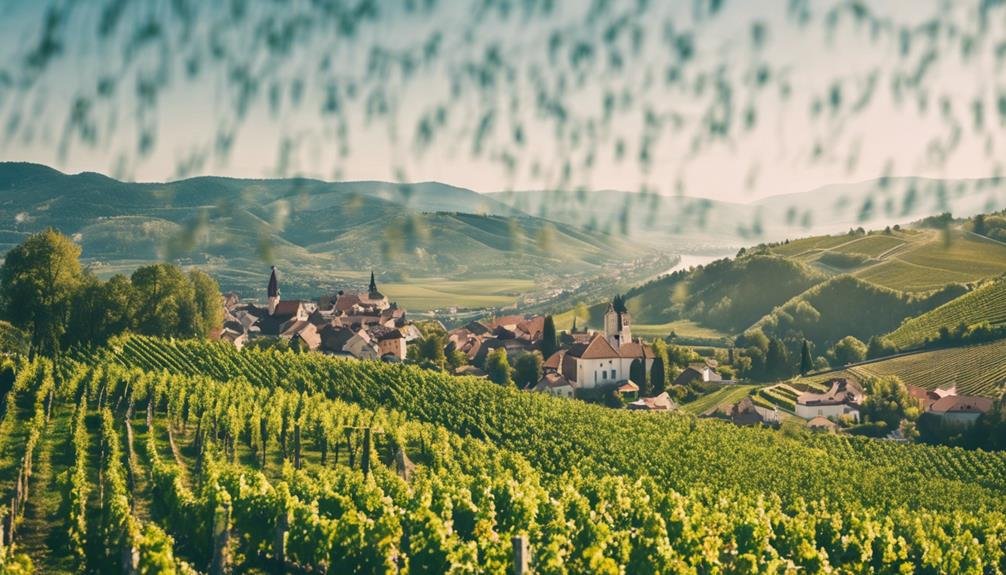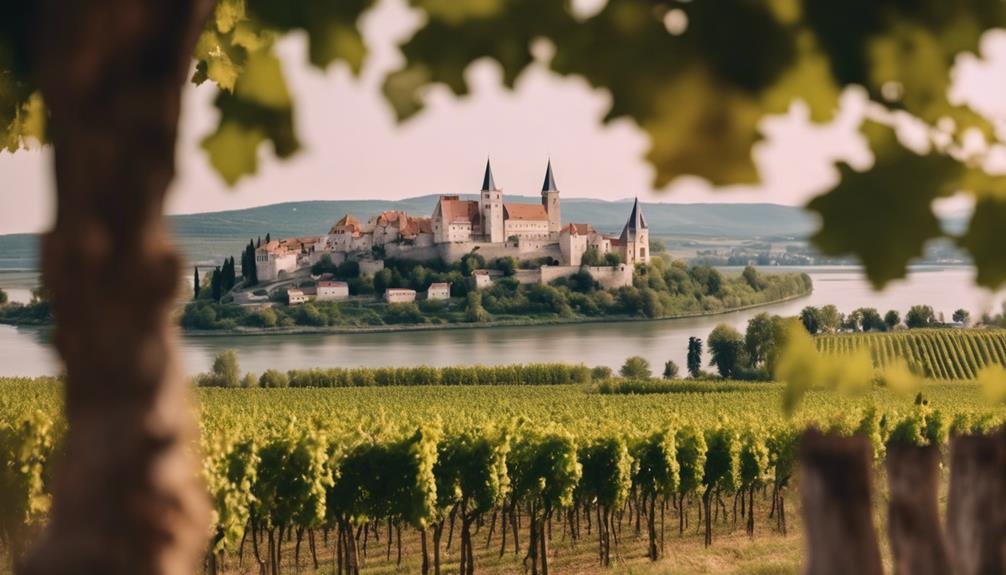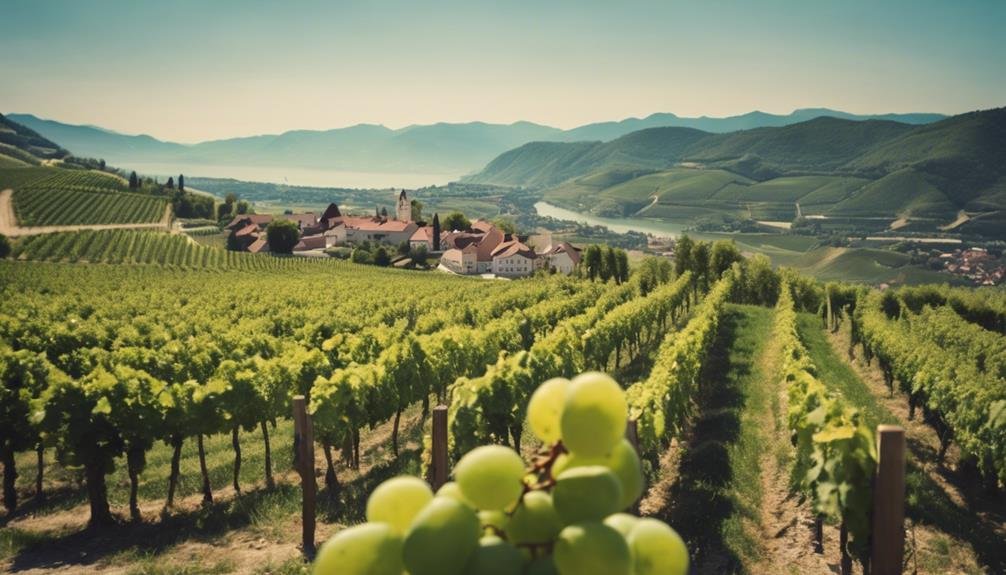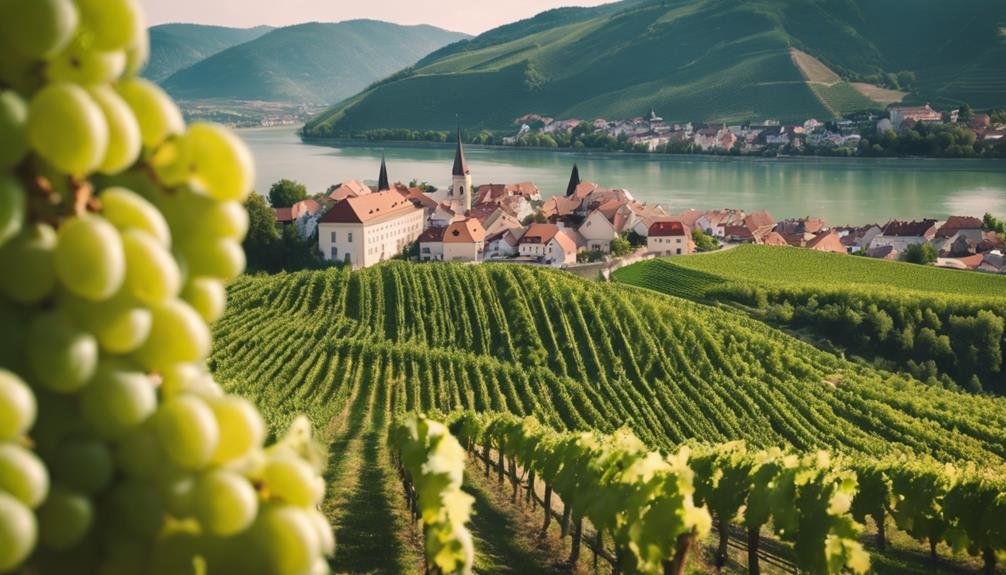The Wachau Wine Region flourishes along the Danube River, known for its steep vineyard terraces and flourishing winemaking history. Iconic wineries such as Hirtzberger, Gritsch, and Nikolaihof embody centuries of viticultural excellence. Riesling and Grüner Veltliner grapes thrive among 124 vineyards and 650 growers across 3340 acres. Unique terroir influences shape their distinct flavors, emphasizing quality and tradition. Ancient stone terraces and geological formations play a crucial role in nurturing Wachau wines. Culinary delights, scenic hikes in Durnstein, and historical sites like Melk Abbey paint a vivid picture of this wine region's cultural tapestry. Discover the secrets behind Wachau's wine treasures.
Danube River and Wachau Geography
Nestled along the meandering path of the Danube River, the Wachau region showcases a unique geographical setting that influences its winemaking practices and climate characteristics. The region's natural landscapes, characterized by steep terraced vineyards, are a result of the Danube's presence, shaping the viticultural practices of the area.
Popular for river cruises, visitors can admire the stunning scenery while learning about the region's winemaking heritage. The Danube River not only contributes to the picturesque views but also plays an essential role in moderating the climate of Wachau, creating a suitable environment for grape cultivation. These factors make the Wachau region a must-visit destination for wine enthusiasts seeking a blend of natural beauty and exceptional wine experiences.
Historical Wineries and Vineyards
The rich history of winemaking in the Wachau region is intricately intertwined with its storied vineyards and historical wineries, showcasing a legacy that spans generations. Some wineries in Wachau can trace their roots back 8 generations, carrying forward ancient traditions and generational legacies. Prominent wineries like Hirtzberger, Gritsch, Weingut Maccherndl, and Austria's oldest winery, Nikolaihof, dating back to 777, contribute to the region's esteemed viticultural heritage.
With 124 vineyards, 650 growers, and 3340 acres planted primarily with Riesling and Grüner Veltliner grapes, Wachau's winemaking prowess is deeply rooted in tradition and expertise. These historical wineries and vineyards embody the essence of Wachau's winemaking excellence, showcasing a commitment to quality that has stood the test of time.
Wines and Winemaking in Wachau

With a focus on Riesling and Grüner Veltliner, the winemaking practices in the Wachau region are renowned for their dedication to high-quality wines.
Terroir influences, such as climate and soil composition, play an essential role in shaping the region's wine styles, ranging from lean and acidic to rich and fleshy.
Winemakers in Wachau emphasize fermentation techniques that bring out the best in these grape varieties, with a particular focus on showcasing the unique characteristics of the vineyard sites.
The aging process is carefully monitored, with restrictions on oak flavors to maintain the purity of the wines. This attention to detail and respect for the terroir contribute to the exceptional quality and distinctiveness of Wachau wines.
Vineyard Terraces and Geology
In understanding the distinctive characteristics of Wachau wines, the ancient vineyard terraces and geological formations of the region play a pivotal role in shaping the quality and unique flavors of the wines produced.
The Wachau region features 1000-year-old stone wall terraces that retain heat and protect against erosion, essential for viticulture on the steep slopes. Geological influences, such as unique geology transformed by tectonic collisions and the Danube River, have resulted in granite mountains evolving into gneiss, marble, and amphibolite.
Additionally, loess deposits from Ice Age winds contribute to the terroir impact, affecting wine characteristics. These factors create a diverse and rich environment for grape cultivation, showcasing the intricate relationship between terroir and wine quality in the Wachau region.
Visitor Recommendations and Attractions

Exploring the cultural and historical attractions of the Wachau region offers visitors a rich tapestry of experiences beyond its renowned wines. Culinary delights await at Wachauerstube and Gasthof Prankl, where traditional Austrian cuisine can be savored.
For those seeking outdoor adventures, scenic hikes in Durnstein provide breathtaking views of the picturesque landscapes. Additionally, exploring Melk Abbey and Weissenkirchen offers insights into the region's rich history and architectural heritage.
These attractions not only complement the wine experience but also provide a deeper understanding of the cultural fabric of Wachau.
Lindsay Pomeroy, a seasoned wine educator, shares valuable insights into the region's wine culture, while resources like the Wine Folly newsletter can enhance visitors' wine education and appreciation.
Cultural Insights and Wine Education
Cultural immersion in the Wachau region intertwines historical narratives with the artistry of winemaking, offering visitors a multifaceted journey of discovery. Traditional customs play an essential role in shaping the winemaking practices of the region, where generations have passed down knowledge and techniques. Understanding these customs enhances the appreciation of the wines produced in Wachau.
Wine pairing is also a crucial aspect of cultural insights, with local dishes complementing the distinct flavors of Riesling and Grüner Veltliner. Visitors can engage in educational experiences, learning about the unique terroir and winemaking processes that define the region. Exploring these cultural aspects enriches the overall wine-tasting experience, providing a deeper connection to the traditions and heritage of Wachau.
Additional Resources for Wine Enthusiasts

For wine enthusiasts seeking to explore further into the world of Wachau wines, there are valuable resources available to enhance their knowledge and appreciation. Understanding wine education and the terroir impact on Wachau wines is essential for a thorough experience. Below is a table highlighting some key resources:
| Resource | Description |
|---|---|
| Wine Folly Newsletter | Offers insightful articles, guides, and recommendations for wine enthusiasts interested in Wachau wines. |
| Wachau Wine School | Provides in-depth courses and tastings to deepen knowledge about the region's wines and winemaking. |
| Terroir Talks Podcast | Explores the influence of terroir on Wachau wines through interviews with local winemakers and experts. |
Frequently Asked Questions
How Do the Danube River's Currents Influence the Terroir of Wachau's Vineyards?
The Danube River's currents impact Wachau's vineyards through soil composition influenced by ancient stone terraces. The cool Central European climate enhances the quality of Riesling and Grüner Veltliner grapes. Winemaking techniques focus on reflecting terroir, restricting oak influence.
What Traditional Winemaking Techniques Are Unique to the Wachau Region?
Traditional winemaking techniques in the Wachau region include spontaneous fermentation, extended maceration, and aging in large oak casks. Vineyard management emphasizes hand-harvesting on steep terraces. The unique soil composition, coupled with the climate impact, shapes the region's distinctive wines.
How Have the Ancient Stone Terraces in Wachau Evolved Over Time?
The ancient stone terraces in Wachau have evolved over time through meticulous maintenance, adapting to modern viticulture practices while preserving their cultural significance. These terraces showcase the region's rich history and are essential for grape cultivation.
Are There Specific Hiking Trails in Wachau That Offer Vineyard Views?
Among the picturesque hiking trails in Wachau, some offer alluring vineyard viewpoints. These paths not only provide scenic beauty but also create an ambiance perfect for wine tasting or sunset hikes, enhancing the overall experience.
What Makes Nikolaihof Austrias Oldest Winery, and How Has It Maintained Its Legacy?
Nikolaihof stands as Austria's oldest winery due to its heritage dating back to 777. The winery's legacy thrives through sustainable practices and family-owned traditions, ensuring continuity in producing quality wines and preserving historical significance.
Conclusion
To sum up, the Wachau wine region offers a fascinating blend of history, geography, and winemaking traditions that contribute to its unique terroir.
For example, the ancient stone terraces and diverse geology of the region play a significant role in shaping the distinct flavors of Riesling and Grüner Veltliner wines.
Exploring the cultural landmarks and attractions in Wachau provides a deeper understanding and appreciation of its rich heritage.
